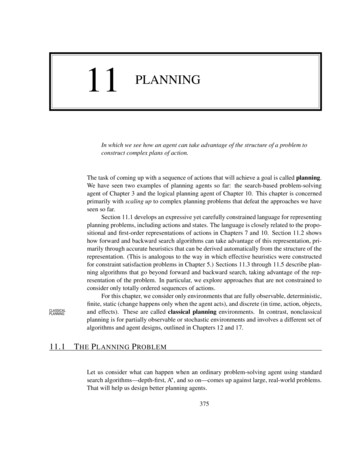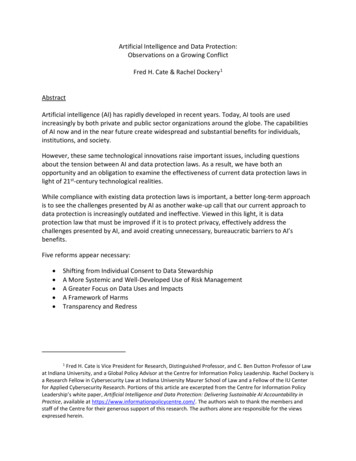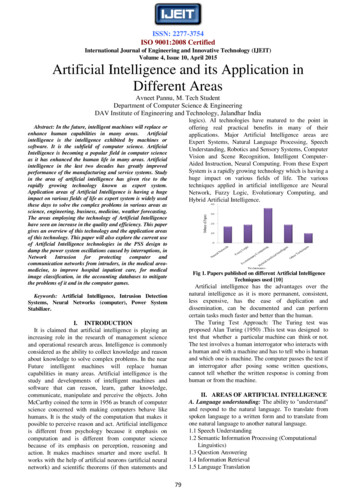
Transcription
11PLANNINGIn which we see how an agent can take advantage of the structure of a problem toconstruct complex plans of action.CLASSICALPLANNING11.1The task of coming up with a sequence of actions that will achieve a goal is called planning.We have seen two examples of planning agents so far: the search-based problem-solvingagent of Chapter 3 and the logical planning agent of Chapter 10. This chapter is concernedprimarily with scaling up to complex planning problems that defeat the approaches we haveseen so far.Section 11.1 develops an expressive yet carefully constrained language for representingplanning problems, including actions and states. The language is closely related to the propositional and first-order representations of actions in Chapters 7 and 10. Section 11.2 showshow forward and backward search algorithms can take advantage of this representation, primarily through accurate heuristics that can be derived automatically from the structure of therepresentation. (This is analogous to the way in which effective heuristics were constructedfor constraint satisfaction problems in Chapter 5.) Sections 11.3 through 11.5 describe planning algorithms that go beyond forward and backward search, taking advantage of the representation of the problem. In particular, we explore approaches that are not constrained toconsider only totally ordered sequences of actions.For this chapter, we consider only environments that are fully observable, deterministic,finite, static (change happens only when the agent acts), and discrete (in time, action, objects,and effects). These are called classical planning environments. In contrast, nonclassicalplanning is for partially observable or stochastic environments and involves a different set ofalgorithms and agent designs, outlined in Chapters 12 and 17.T HE P LANNING P ROBLEMLet us consider what can happen when an ordinary problem-solving agent using standardsearch algorithms—depth-first, A , and so on—comes up against large, real-world problems.That will help us design better planning agents.375
376PROBLEMDECOMPOSITIONNEARLYDECOMPOSABLEChapter 11.PlanningThe most obvious difficulty is that the problem-solving agent can be overwhelmed byirrelevant actions. Consider the task of buying a copy of AI: A Modern Approach from anonline bookseller. Suppose there is one buying action for each 10-digit ISBN number, for atotal of 10 billion actions. The search algorithm would have to examine the outcome statesof all 10 billion actions to find one that satisfies the goal, which is to own a copy of ISBN0137903952. A sensible planning agent, on the other hand, should be able to work backfrom an explicit goal description such as Have(ISBN 0137903952) and generate the actionBuy(ISBN 0137903952) directly. To do this, the agent simply needs the general knowledgethat Buy(x) results in Have(x). Given this knowledge and the goal, the planner can decidein a single unification step that Buy(ISBN 0137903952) is the right action.The next difficulty is finding a good heuristic function. Suppose the agent’s goal is tobuy four different books online. Then there will be 1040 plans of just four steps, so searchingwithout an accurate heuristic is out of the question. It is obvious to a human that a goodheuristic estimate for the cost of a state is the number of books that remain to be bought;unfortunately, this insight is not obvious to a problem-solving agent, because it sees the goaltest only as a black box that returns true or false for each state. Therefore, the problemsolving agent lacks autonomy; it requires a human to supply a heuristic function for each newproblem. On the other hand, if a planning agent has access to an explicit representation of thegoal as a conjunction of subgoals, then it can use a single domain-independent heuristic: thenumber of unsatisfied conjuncts. For the book-buying problem, the goal would be Have(A) Have(B) Have(C) Have(D), and a state containing Have(A) Have(C) would havecost 2. Thus, the agent automatically gets the right heuristic for this problem, and for manyothers. We shall see later in the chapter how to construct more sophisticated heuristics thatexamine the available actions as well as the structure of the goal.Finally, the problem solver might be inefficient because it cannot take advantage ofproblem decomposition. Consider the problem of delivering a set of overnight packages totheir respective destinations, which are scattered across Australia. It makes sense to find outthe nearest airport for each destination and divide the overall problem into several subproblems, one for each airport. Within the set of packages routed through a given airport, whetherfurther decomposition is possible depends on the destination city. We saw in Chapter 5 thatthe ability to do this kind of decomposition contributes to the efficiency of constraint satisfaction problem solvers. The same holds true for planners: in the worst case, it can take O(n!)time to find the best plan to deliver n packages, but only O((n/k)! k) time if the problemcan be decomposed into k equal parts.As we noted in Chapter 5, perfectly decomposable problems are delicious but rare. 1The design of many planning systems—particularly the partial-order planners described inSection 11.3—is based on the assumption that most real-world problems are nearly decomposable. That is, the planner can work on subgoals independently, but might need to dosome additional work to combine the resulting subplans. For some problems, this assump1 Notice that even the delivery of a package is not perfectly decomposable. There may be cases in which itis better to assign packages to a more distant airport if that renders a flight to the nearest airport unnecessary.Nevertheless, most delivery companies prefer the computational and organizational simplicity of sticking withdecomposed solutions.
Section 11.1.The Planning Problem377tion breaks down because working on one subgoal is likely to undo another subgoal. Theseinteractions among subgoals are what makes puzzles (like the 8-puzzle) puzzling.The language of planning problemsGOAL SATISFACTIONThe preceding discussion suggests that the representation of planning problems—states, actions, and goals—should make it possible for planning algorithms to take advantage of thelogical structure of the problem. The key is to find a language that is expressive enough todescribe a wide variety of problems, but restrictive enough to allow efficient algorithms tooperate over it. In this section, we first outline the basic representation language of classicalplanners, known as the S TRIPS language.2 Later, we point out some of the many possiblevariations in S TRIPS-like languages.Representation of states. Planners decompose the world into logical conditions andrepresent a state as a conjunction of positive literals. We will consider propositional literals;for example, Poor Unknown might represent the state of a hapless agent. We will alsouse first-order literals; for example, At(Plane 1 , Melbourne) At(Plane 2 , Sydney) mightrepresent a state in the package delivery problem. Literals in first-order state descriptionsmust be ground and function-free. Literals such as At(x, y) or At(Father (Fred), Sydney)are not allowed. The closed-world assumption is used, meaning that any conditions that arenot mentioned in a state are assumed false.Representation of goals. A goal is a partially specified state, represented as a conjunction of positive ground literals, such as Rich Famous or At (P2 , Tahiti). A propositionalstate s satisfies a goal g if s contains all the atoms in g (and possibly others). For example,the state Rich Famous Miserable satisfies the goal Rich Famous.Representation of actions. An action is specified in terms of the preconditions thatmust hold before it can be executed and the effects that ensue when it is executed. Forexample, an action for flying a plane from one location to another is:Action(Fly(p, from, to),P RECOND :At(p, from) Plane(p) Airport(from) Airport(to)E FFECT: At (p, from) At(p, to))ACTION SCHEMAThis is more properly called an action schema, meaning that it represents a number of different actions that can be derived by instantiating the variables p, from, and to to differentconstants. In general, an action schema consists of three parts: The action name and parameter list—for example, Fly(p, from, to)—serves to identifythe action.PRECONDITION The precondition is a conjunction of function-free positive literals stating what mustbe true in a state before the action can be executed. Any variables in the preconditionmust also appear in the action’s parameter list.EFFECT The effect is a conjunction of function-free literals describing how the state changeswhen the action is executed. A positive literal P in the effect is asserted to be true in2S TRIPS stands for STanford Research Institute Problem Solver.
378Chapter 11.Planningthe state resulting from the action, whereas a negative literal P is asserted to be false.Variables in the effect must also appear in the action’s parameter list.ADD LISTDELETE LISTAPPLICABLETo improve readability, some planning systems divide the effect into the add list for positiveliterals and the delete list for negative literals.Having defined the syntax for representations of planning problems, we can now definethe semantics. The most straightforward way to do this is to describe how actions affectstates. (An alternative method is to specify a direct translation into successor-state axioms,whose semantics comes from first-order logic; see Exercise 11.3.) First, we say that an actionis applicable in any state that satisfies the precondition; otherwise, the action has no effect.For a first-order action schema, establishing applicability will involve a substitution θ for thevariables in the precondition. For example, suppose the current state is described byAt(P1 , JFK ) At(P2 , SFO) Plane(P1 ) Plane(P2 ) Airport(JFK ) Airport(SFO) .This state satisfies the preconditionAt(p, from) Plane(p) Airport(from) Airport(to)RESULTwith substitution {p/P1 , from/JFK , to/SFO} (among others—see Exercise 11.2). Thus,the concrete action Fly(P1 , JFK , SFO) is applicable.Starting in state s, the result of executing an applicable action a is a state s 0 that is thesame as s except that any positive literal P in the effect of a is added to s0 and any negativeliteral P is removed from s0 . Thus, after Fly(P1 , JFK , SFO), the current state becomesAt(P1 , SFO) At(P2 , SFO) Plane(P1 ) Plane(P2 ) Airport(JFK ) Airport(SFO) .STRIPS ASSUMPTIONSOLUTIONNote that if a positive effect is already in s it is not added twice, and if a negative effect isnot in s, then that part of the effect is ignored. This definition embodies the so-called S TRIPSassumption: that every literal not mentioned in the effect remains unchanged. In this way,S TRIPS avoids the representational frame problem described in Chapter 10.Finally, we can define the solution for a planning problem. In its simplest form, this isjust an action sequence that, when executed in the initial state, results in a state that satisfiesthe goal. Later in the chapter, we will allow solutions to be partially ordered sets of actions,provided that every action sequence that respects the partial order is a solution.Expressiveness and extensionsThe various restrictions imposed by the S TRIPS representation were chosen in the hope ofmaking planning algorithms simpler and more efficient, without making it too difficult todescribe real problems. One of the most important restrictions is that literals be functionfree. With this restriction, we can be sure that any action schema for a given problem canbe propositionalized—that is, turned into a finite collection of purely propositional actionrepresentations with no variables. (See Chapter 9 for more on this topic.) For example, inthe air cargo domain for a problem with 10 planes and five airports, we could translate theFly(p, from, to) schema into 10 5 5 250 purely propositional actions. The planners
Section 11.1.The Planning Problem379S TRIPS LanguageADL LanguageOnly positive literals in states:Poor UnknownPositive and negative literals in states: Rich FamousClosed World Assumption:Unmentioned literals are false.Open World Assumption:Unmentioned literals are unknown.Effect P Q means add P and delete Q.Effect P Q means add P and Qand delete P and Q.Only ground literals in goals:Rich FamousQuantified variables in goals: xAt (P1 , x) At(P2 , x) is the goal ofhaving P1 and P2 in the same place.Goals are conjunctions:Rich FamousGoals allow conjunction and disjunction: Poor (Famous Smart)Effects are conjunctions.Conditional effects allowed:when P : E means E is an effectonly if P is satisfied.No support for equality.Equality predicate (x y) is built in.No support for types.Variables can have types, as in (p : Plane).Figure 11.1 Comparison of S TRIPS and ADL languages for representing planning problems. In both cases, goals behave as the preconditions of an action with no parameters.ADLin Sections 11.4 and 11.5 work directly with propositionalized descriptions. If we allowfunction symbols, then infinitely many states and actions can be constructed.In recent years, it has become clear that S TRIPS is insufficiently expressive for somereal domains. As a result, many language variants have been developed. Figure 11.1 brieflydescribes one important one, the Action Description Language or ADL, by comparing it withthe basic S TRIPS language. In ADL, the Fly action could be written asAction(Fly(p : Plane, from : Airport, to : Airport),P RECOND :At(p, from) (from 6 to)E FFECT: At (p, from) At(p, to)) .The notation p : Plane in the parameter list is an abbreviation for Plane(p) in the precondition; this adds no expressive power, but can be easier to read. (It also cuts down on the numberof possible propositional actions that can be constructed.) The precondition (from 6 to) expresses the fact that a flight cannot be made from an airport to itself. This could not beexpressed succinctly in S TRIPS.The various planning formalisms used in AI have been systematized within a standardsyntax called the the Planning Domain Definition Language, or PDDL. This language allowsresearchers to exchange becnchmark problems and compare results. PDDL includes sublanguages for S TRIPS, ADL, and the hierarchical task networks we will see in Chapter 12.
380Chapter 11.PlanningInit(At(C1 , SFO) At(C2 , JFK ) At(P1 , SFO ) At(P2 , JFK ) Cargo(C1 ) Cargo(C2 ) Plane(P1 ) Plane(P2 ) Airport(JFK ) Airport(SFO))Goal (At(C1 , JFK ) At(C2 , SFO))Action(Load(c, p, a),P RECOND : At(c, a) At(p, a) Cargo(c) Plane(p) Airport(a)E FFECT: At(c, a) In(c, p))Action(Unload (c, p, a),P RECOND : In(c, p) At (p, a) Cargo(c) Plane(p) Airport(a)E FFECT: At(c, a) In(c, p))Action(Fly(p, from, to),P RECOND : At(p, from) Plane(p) Airport(from) Airport(to)E FFECT: At(p, from) At(p, to))Figure 11.2STATE CONSTRAINTSA S TRIPS problem involving transportation of air cargo between airports.The S TRIPS and ADL notations are adequate for many real domains. The subsectionsthat follow show some simple examples. There are still some significant restrictions, however. The most obvious is that they cannot represent in a natural way the ramifications ofactions. For example, if there are people, packages, or dust motes in the airplane, then theytoo change location when the plane flies. We can represent these changes as the direct effects of flying, whereas it seems more natural to represent the location of the plane’s contentsas a logical consequence of the location of the plane. We will see more examples of suchstate constraints in Section 11.5. Classical planning systems do not even attempt to addressthe qualification problem: the problem of unrepresented circumstances that could cause anaction to fail. We will see how to address qualifications in Chapter 12.Example: Air cargo transportFigure 11.2 shows an air cargo transport problem involving loading and unloading cargo ontoand off of planes and flying it from place to place. The problem can be defined with threeactions: Load, Unload , and Fly. The actions affect two predicates: In(c, p) means that cargoc is inside plane p, and At (x, a) means that object x (either plane or cargo) is at airport a.Note that cargo is not At anywhere when it is In a plane, so At really means “availablefor use at a given location.” It takes some experience with action definitions to handle suchdetails consistently. The following plan is a solution to the problem:[Load(C1 , P1 , SFO), Fly(P1 , SFO, JFK ),Load(C2 , P2 , JFK ), Fly(P2 , JFK , SFO)] .Our representation is pure S TRIPS. In particular, it allows a plane to fly to and from the sameairport. Inequality literals in ADL could prevent this.
Section 11.1.The Planning Problem381Example: The spare tire problemConsider the problem of changing a flat tire. More precisely, the goal is to have a good sparetire properly mounted onto the car’s axle, where the initial state has a flat tire on the axle anda good spare tire in the trunk. To keep it simple, our version of the problem is a very abstractone, with no sticky lug nuts or other complications. There are just four actions: removingthe spare from the trunk, removing the flat tire from the axle, putting the spare on the axle,and leaving the car unattended overnight. We assume that the car is in a particularly badneighborhood, so that the effect of leaving it overnight is that the tires disappear.The ADL description of the problem is shown in Figure 11.3. Notice that it is purelypropositional. It goes beyond S TRIPS in that it uses a negated precondition, At(Flat, Axle),for the PutOn(Spare, Axle) action. This could be avoided by using Clear (Axle) instead, aswe will see in the next example.Init(At(Flat, Axle) At(Spare, Trunk ))Goal (At(Spare, Axle))Action(Remove(Spare, Trunk ),P RECOND : At (Spare, Trunk )E FFECT: At(Spare, Trunk ) At(Spare, Ground ))Action(Remove(Flat, Axle),P RECOND : At (Flat, Axle)E FFECT: At(Flat , Axle) At(Flat, Ground ))Action(PutOn(Spare, Axle),P RECOND : At(Spare, Ground ) At(Flat, Axle)E FFECT: At(Spare, Ground ) At(Spare, Axle))Action(LeaveOvernight ,P RECOND :E FFECT: At(Spare, Ground ) At(Spare, Axle) At(Spare, Trunk ) At(Flat, Ground ) At(Flat , Axle))Figure 11.3The simple spare tire problem.Example: The blocks worldBLOCKS WORLDOne of the most famous planning domains is known as the blocks world. This domainconsists of a set of cube-shaped blocks sitting on a table.3 The blocks can be stacked, butonly one block can fit directly on top of another. A robot arm can pick up a block and moveit to another position, either on the table or on top of another block. The arm can pick uponly one block at a time, so it cannot pick up a block that has another one on it. The goal willalways be to build one or more stacks of blocks, specified in terms of what blocks are on topof what other blocks. For example, a goal might be to get block A on B and block C on D.3The blocks world used in planning research is much simpler than S HRDLU’s version, shown on page 20.
382Chapter 11.PlanningWe will use On(b, x) to indicate that block b is on x, where x is either another block orthe table. The action for moving block b from the top of x to the top of y will be Move(b, x, y).Now, one of the preconditions on moving b is that no other block be on it. In first-orderlogic, this would be x On(x, b) or, alternatively, x On(x, b). These could be stated aspreconditions in ADL. We can stay within the S TRIPS language, however, by introducing anew predicate, Clear (x), that is true when nothing is on x.The action Move moves a block b from x to y if both b and y are clear. After the moveis made, x is clear but y is not. A formal description of Move in S TRIPS isAction(Move(b, x, y),P RECOND :On(b, x) Clear (b) Clear (y),E FFECT:On(b, y) Clear (x) On(b, x) Clear (y)) .Unfortunately, this action does not maintain Clear properly when x or y is the table. Whenx Table, this action has the effect Clear (Table), but the table should not become clear, andwhen y Table, it has the precondition Clear (Table), but the table does not have to be clearto move a block onto it. To fix this, we do two things. First, we introduce another action tomove a block b from x to the table:Action(MoveToTable(b, x),P RECOND :On(b, x) Clear (b)),E FFECT:On(b, Table) Clear (x) On(b, x)) .Second, we take the interpretation of Clear (b) to be “there is a clear space on b to hold ablock.” Under this interpretation, Clear (Table) will always be true. The only problem is thatnothing prevents the planner from using Move(b, x, Table) instead of MoveToTable(b, x).We could live with this problem—it will lead to a larger-than-necessary search space, but willnot lead to incorrect answers—or we could introduce the predicate Block and add Block (b) Block (y) to the precondition of Move.Finally, there is the problem of spurious actions such as Move(B, C, C), which shouldbe a no-op, but which has contradictory effects. It is common to ignore such problems,because they seldom cause incorrect plans to be produced. The correct approach is add inequality preconditions as shown in Figure 11.4.11.2P LANNING WITH S TATE -S PACE S EARCHNow we turn our attention to planning algorithms. The most straightforward approach is touse state-space search. Because the descriptions of actions in a planning problem specifyboth preconditions and effects, it is possible to search in either direction: either forward fromthe initial state or backward from the goal, as shown in Figure 11.5. We can also use theexplicit action and goal representations to derive effective heuristics automatically.Forward state-space searchPROGRESSIONPlanning with forward state-space search is similar to the problem-solving approach of Chapter 3. It is sometimes called progression planning, because it moves in the forward direction.
Section 11.2.Planning with State-Space Search383Init(On(A, Table) On(B, Table) On(C, Table) Block (A) Block (B) Block (C) Clear (A) Clear (B) Clear (C))Goal (On(A, B) On(B, C))Action(Move(b, x, y),P RECOND : On(b, x) Clear (b) Clear (y) Block (b) (b 6 x) (b 6 y) (x 6 y),E FFECT: On(b, y) Clear (x) On(b, x) Clear (y))Action(MoveToTable(b, x),P RECOND : On(b, x) Clear (b) Block (b) (b 6 x),E FFECT: On(b, Table) Clear (x) On(b, x))Figure 11.4 A planning problem in the blocks world: building a three-block tower. Onesolution is the sequence [Move(B, Table, C), Move(A, Table, B)].At(P1, B)(a)Fly(P1, A, B)At(P2, A)Fly(P2, A, B)At(P1, A)At(P1, A)At(P2, A)At(P2, B)At(P1, A)At(P2, B)Fly(P1, A, B)At(P1, B)Fly(P2, A, B)At(P1, B)(b)At(P2, B)At(P2, A)Figure 11.5 Two approaches to searching for a plan. (a) Forward (progression) state-spacesearch, starting in the initial state and using the problem’s actions to search forward for thegoal state. (b) Backward (regression) state-space search: a belief-state search (see page 84)starting at the goal state(s) and using the inverse of the actions to search backward for theinitial state.We start in the problem’s initial state, considering sequences of actions until we find a sequence that reaches a goal state. The formulation of planning problems as state-space searchproblems is as follows: The initial state of the search is the initial state from the planning problem. In general,each state will be a set of positive ground literals; literals not appearing are false.
384Chapter 11.Planning The actions that are applicable to a state are all those whose preconditions are satisfied.The successor state resulting from an action is generated by adding the positive effectliterals and deleting the negative effect literals. (In the first-order case, we must applythe unifier from the preconditions to the effect literals.) Note that a single successorfunction works for all planning problems—a consequence of using an explicit actionrepresentation. The goal test checks whether the state satisfies the goal of the planning problem. The step cost of each action is typically 1. Although it would be easy to allow differentcosts for different actions, this is seldom done by S TRIPS planners.Recall that, in the absence of function symbols, the state space of a planning problem is finite.Therefore, any graph search algorithm that is complete—for example, A —will be a completeplanning algorithm.From the earliest days of planning research (around 1961) until recently (around 1998)it was assumed that forward state-space search was too inefficient to be practical. It is nothard to come up with reasons why—just refer back to the start of Section 11.1. First, forwardsearch does not address the irrelevant action problem—all applicable actions are consideredfrom each state. Second, the approach quickly bogs down without a good heuristic. Consideran air cargo problem with 10 airports, where each airport has 5 planes and 20 pieces of cargo.The goal is to move all the cargo at airport A to airport B. There is a simple solution to theproblem: load the 20 pieces of cargo into one of the planes at A, fly the plane to B, and unloadthe cargo. But finding the solution can be difficult because the average branching factor ishuge: each of the 50 planes can fly to 9 other airports, and each of the 200 packages can beeither unloaded (if it is loaded), or loaded into any plane at its airport (if it is unloaded). Onaverage, let’s say there are about 1000 possible actions, so the search tree up to the depth ofthe obvious solution has about 100041 nodes. It is clear that a very accurate heuristic will beneeded to make this kind of search efficient. We will discuss some possible heuristics afterlooking at backward search.Backward state-space searchRELEVANCEBackward state-space search was described briefly as part of bidirectional search in Chapter 3.We noted there that backward search can be difficult to implement when the goal states aredescribed by a set of constraints rather than being listed explicitly. In particular, it is notalways obvious how to generate a description of the possible predecessors of the set of goalstates. We will see that the S TRIPS representation makes this quite easy because sets of statescan be described by the literals that must be true in those states.The main advantage of backward search is that it allows us to consider only relevantactions. An action is relevant to a conjunctive goal if it achieves one of the conjuncts of thegoal. For example, the goal in our 10-airport air cargo problem is to have 20 pieces of cargoat airport B, or more precisely,At(C1 , B) At(C2 , B) . . . At(C20 , B) .Now consider the conjunct At(C1 , B). Working backwards, we can seek actions that havethis as an effect. There is only one: Unload (C1 , p, B), where plane p is unspecified.
Section 11.2.REGRESSIONPlanning with State-Space Search385Notice that there are many irrelevant actions that can also lead to a goal state. Forexample, we can fly an empty plane from JFK to SFO; this action reaches a goal state froma predecessor state in which the plane is at JFK and all the goal conjuncts are satisfied. Abackward search that allows irrelevant actions will still be complete, but it will be much lessefficient. If a solution exists, it will be found by a backward search that allows only relevantactions. The restriction to relevant actions means that backward search often has a muchlower branching factor than forward search. For example, our air cargo problem has about1000 actions leading forward from the initial state, but only 20 actions working backwardfrom the goal.Searching backwards is sometimes called regression planning. The principal questionin regression planning is this: what are the states from which applying a given action leads tothe goal? Computing the description of these states is called regressing the goal through theaction. To see how to do it, consider the air cargo example. We have the goalAt(C1 , B) At(C2 , B) . . . At(C20 , B)and the relevant action Unload (C1 , p, B), which achieves the first conjunct. The action willwork only if its preconditions are satisfied. Therefore, any predecessor state must includethese preconditions: In(C1 , p) At(p, B). Moreover, the subgoal At(C1 , B) should not betrue in the predecessor state.4 Thus, the predecessor description isIn(C1 , p) At (p, B) At(C2 , B) . . . At(C20 , B) .CONSISTENCYIn addition to insisting that actions achieve some desired literal, we must insist that the actionsnot undo any desired literals. An action that satisfies this restriction is called consistent. Forexample, the action Load(C2 , p) would not be consistent with the current goal, because itwould negate the literal At(C2 , B).Given definitions of relevance and consistency, we can describe the general process ofconstructing predecessors for backward search. Given a goal description G, let A be an actionthat is relevant and consistent. The corresponding predecessor is as follows: Any positive effects of A that appear in G are deleted. Each precondition literal of A is added, unless it already appears.Any of the standard search algorithms can be used to carry out the search. Termination occurswhen a predecessor description is generated that is satisfied by the initial state of the planningproblem. In the first-order case, satisfaction might require a substitution for variables in thepredecessor description. For example, the predecessor description in the preceding paragraphis satisfied by the initial stateIn(C1 , P12 ) At(P12 , B) At(C2 , B) . . . At(C20 , B)with substitution {p/P12 }. The substitution must be applied to the actions leading from thestate to th
number of unsatisfied conjuncts. For the book-buying problem, the goal would be Have(A) Have(B) Have(C) Have(D), and a state containing Have(A) Have(C) would have cost 2. Thus, the agent automatically gets the right heuristic for this problem, and for many others. We shall see lat











